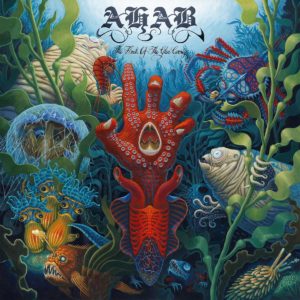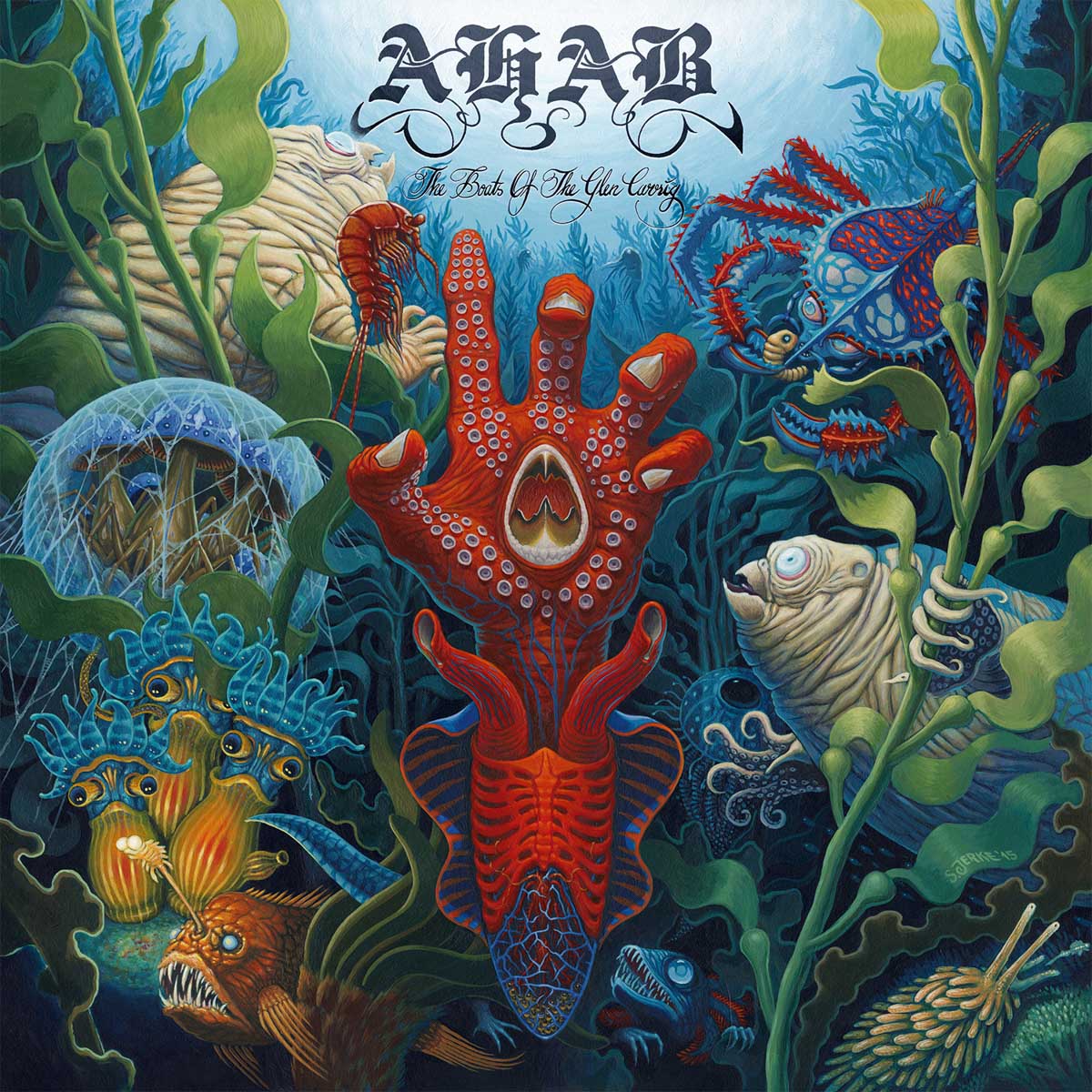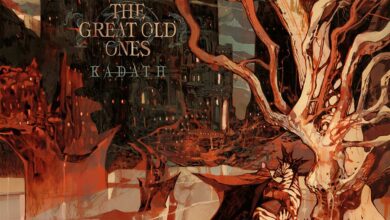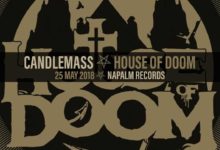From the Depths of the Sargasso Sea, AHAB Conjures the Nightmarish Visions of “The Boats of the Glen Carrig”
 Rare is the band that can evolve beyond the constraints of a niche genre and still maintain continuity with their signature sound. However, for the better part of the past decade, the German leviathan known as Ahab has been a harbinger of nautical-themed funeral doom metal, releasing three genre-defining full-length albums that ebb and flow with profound despair and melancholy, while continually striving to expand on the repertoire by blending elements of jazz-infused prog, atmospheric post rock, doom, and sludge into a uniquely foreboding aesthetic. Ahab’s fourth release, The Boats of the Glen Carrig, is arguably their most progressive and proves to be an album of exceptional stylistic breadth.
Rare is the band that can evolve beyond the constraints of a niche genre and still maintain continuity with their signature sound. However, for the better part of the past decade, the German leviathan known as Ahab has been a harbinger of nautical-themed funeral doom metal, releasing three genre-defining full-length albums that ebb and flow with profound despair and melancholy, while continually striving to expand on the repertoire by blending elements of jazz-infused prog, atmospheric post rock, doom, and sludge into a uniquely foreboding aesthetic. Ahab’s fourth release, The Boats of the Glen Carrig, is arguably their most progressive and proves to be an album of exceptional stylistic breadth.
Immersed in the legends of oceanic literature, the members of Ahab are no strangers to navigating their way through the old stories of the sea. Ahab’s 2006 debut album, The Call of the Wretched Sea, found its inspiration in the classic novel ‘Moby-Dick’ by Herman Melville, followed by their sophomore outing, The Divinity of Oceans in 2009, which was influenced by the tragic tale of the whale-ship Essex found in the ‘Narrative of the Most Extraordinary and Distressing Shipwreck of the Whale-Ship Essex’ by First Mate Owen Chase, as well as ‘In the Heart of the Sea’ by Nathaniel Philbrick. In 2012 Ahab released their third album, The Giant, and this time the subject matter revolved around Edgar Allen Poe’s 1838 novel ‘The Narrative of Arthur Gordon Pym of Nantucket’ – the album’s title is a reference to the giant shrouded white figure encountered by the book’s seafaring protagonist, Pym, during his nautical adventures.
Continuing in this tradition, Ahab’s fourth studio release, The Boats of The Glen Carrig, is a concept album based on the eponymous horror novel by William Hope Hodgson. Published in 1907, Hodgson’s tale tells the story of the survivors of the Glen Carrig, which was shipwrecked when it struck a mysterious hidden rock, leaving the remaining crew and passengers adrift in two lifeboats for five days before discovering a strange island – a “land of lonesomeness” inhabited by unnatural vegetation and strange creatures that plague the crew during the night. It is a pre-Lovecraftian tale of the weird and unknown, filled with multi-tentacled “devil-fish” and slimy Weedmen.
 The overarching sense of foreboding that permeates Hodgson’s novel translates superbly into the melancholic doom that Ahab have created on The Boats of The Glen Carrig. Opening track “The Isle” begins with clean singing over calm undulating guitar chords that suggest the feeling of being adrift at sea, before breaking against the heavier crunch and crawl of the main guitar riff, along with Daniel Droste’s inhumanly deep guttural growls create an atmosphere of dread and despair. “The Thing That Made Search” follows a similar pattern with a calm introduction followed by a heavy grinding riff. The track’s strange title is taken from the book’s titular chapter in which the crew are visited at night by an unseen creature that seems to be searching for something, and the sounds they hear through the door of the captain’s quarters are described as if someone were dragging a wet mop around the floor.
The overarching sense of foreboding that permeates Hodgson’s novel translates superbly into the melancholic doom that Ahab have created on The Boats of The Glen Carrig. Opening track “The Isle” begins with clean singing over calm undulating guitar chords that suggest the feeling of being adrift at sea, before breaking against the heavier crunch and crawl of the main guitar riff, along with Daniel Droste’s inhumanly deep guttural growls create an atmosphere of dread and despair. “The Thing That Made Search” follows a similar pattern with a calm introduction followed by a heavy grinding riff. The track’s strange title is taken from the book’s titular chapter in which the crew are visited at night by an unseen creature that seems to be searching for something, and the sounds they hear through the door of the captain’s quarters are described as if someone were dragging a wet mop around the floor.
While the two previous tracks make strides to move beyond the standard dirge tempo of funeral doom, it is on the third track that Ahab truly break free from the shackles of the genre and explore a moderately quicker pace on “Like Red Foam (The Great Storm).” Cornelius Althammer’s drum work, mixed with the sludgy guitar riffs, propels the song forward as Droste bellows in his dread-filled baritone voice – “Call me Winterstraw! Mere passenger of the Glen Carrig!” “The Weedmen” follows with a return to the funeral doom style of early Ahab, opening with a monolithic chord progression and the otherworldly deep guttural growls which conjure images of the monstrous shapes after which the song is named. At exactly fifteen minutes it is also the longest track on the album. The jazz-influenced and delay-soaked chord progression that opens “To Mourn Job” provides an eerie backdrop for Droste’s clean singing style, before crashing into a heavy-as-fuck dissonant sludge riff with guttural vocals and melodic guitar lines woven together throughout.
Bonus track “The Light In The Weed (Mary Madison)” marks Ahab’s first song featuring only clean vocals. There is a definite Opeth-like vibe that calls out on the slower melodic parts throughout The Boats of the Glen Carrig, and the closing track is a wonderful example – a beautifully crafted ballad of sorrow and redemption. So the question raised is why did Ahab choose to include “Mary Madison” as a bonus track rather than a part of the main tracklist? Perhaps it was an attempt to separate it from the main horror narrative of the novel. In Hodgson’s book, the discovery and rescue of the maiden Mary Madison, and subsequent romantic relationship with the narrator Winterstaw that ends the story, seems out of place considering the sense of menace and despair that is prevalent throughout the rest of the story. H.P. Lovecraft commented in his essay “Supernatural Horror in Literature” that the introduction of the romantic element was a “letdown,” but the “brooding menace in the earlier parts of the book is impossible to surpass.” Whatever the reasoning behind including “Mary Madison” as a bonus track, this is a gem worth discovering in the midst of an already impressive treasure of an album.
Ahab have fine-tuned the core sound they’ve developed over the past decade combining the best parts of the first two albums with the more experimental elements found on The Giant, to deliver a watershed album of epic proportions on The Boats of the Glen Carrig.
“The Weedmen dwell
In these depths of green
None of us will live
In their graves at sea”
Listen to “Like Red Foam (The Great Storm)” below
Official Site: www.ahab-doom.de
Facebook: www.facebook.com/AhabDoom
Get “The Boat of the Glen Carrig” at the Napalm Records shop!
Overall - 9
9
Ahab have fine-tuned the core sound they’ve developed over the past decade combining the best parts of the first two albums with the more experimental elements found on The Giant, to deliver a watershed album of epic proportions on The Boats of the Glen Carrig.







